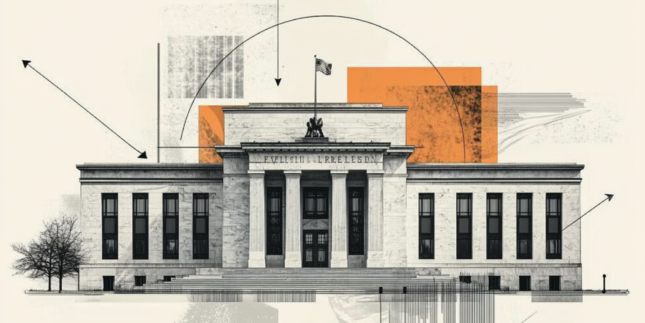Overview: The dollar is better bid today. It is rising against nearly all the G10 currencies, with the Antipodeans bearing the brunt, after a softer than expected Australian inflation report. The yen has steadied after extending its losses to new lows for the year. Emerging market currencies are also mostly lower, though the Mexican peso is edging higher for the fourth consecutive session.
The large Asia Pacific bourses rallied with the exception of China and South Korea. Europe's Stoxx 600 snapped a five-day drop yesterday and is extending the recovery today. US equity futures are paring yesterday's gains. European 10-year yields are mostly 2-3 bp lower, though Italy's yield is flat and the yield of the 10-year Gilt is off four basis points. The US 10-year Treasury yield is slightly below 3.75%. Note that the results of the Fed's bank stress tests will be reported later today. Gold is slipping lower, and near $1907, it is the lowest since mid-March. August WTI held above this month's low (~$67) and has snapped back to near $68.45 in the European morning.
Asia Pacific
The pain threshold of the PBOC with the falling yuan appears to have been approached, given the signal of the recent fixings. Yet, as we have suggested, intervention is best framed as an escalation ladder. The setting of the dollar's reference rate is a low rung on the ladder and perhaps not so dissimilar from the verbal intervention by Japanese officials and its lower dollar fix ended today. It was meant as a cautionary signal to market participants, and arguably, a signal to its trading partners that no trade advantage is being sought. There is no race to the bottom. Yet, at best it is a mild rebuke as the divergence of monetary policy appears to be the main consideration for asset managers and speculative forces. Separately, a US congressional delegation, led by the chair of the US House Armed Services Committee arrived in Taiwan yesterday and met with Taiwan's president earlier today. This, probably even more than US President Biden referring to Xi as a dictator, likely irks Beijing. Nevertheless, US Treasury Secretary Yellen will reportedly visit Beijing early next month as part of the resumed high-level contact. Meanwhile, press reports suggest that the Biden administration is preparing a new screen to limit US investment in China's advanced technology. More controls on technology exports are also reportedly under considerations and this is weighing on some company shares in this space.
Australia's newly issued monthly CPI reading show price pressure moderated more than expected and this further takes pressures off the central bank ahead of next week's meeting. It fell to 5.6% in May from 6.8% in April. The median forecast in Bloomberg's survey was for 6.1%. On this measure, CPI was 6.3% higher year-over-year in March, while the traditional quarterly measure put it at 7.0% at the end of Q1. The RBA surprised the market earlier this month with a 25 bp hike. The record of the meeting showed it was a close call, and from that the market took away the idea that the bar for back-to-back hikes was high. The futures market sees less than a 20% chance of a hike next week, but a move is fully discounted by the end of Q3. A quarter-point hike would bring the overnight cash target rate to 4.35%. The year end rate is seen closer to 4.50%, up from around 4% at the end of last month. Australia's two-year yield fell for the third consecutive session for a cumulative decline of about 15 bp.
The rhetoric of Japan's Vice Minister of International Affairs Kanda has ratcheted up today, warning that officials are monitoring developments "with a sense of increased urgency" and will "respond appropriately" if the moves become excessive." The dollar initially extended yesterday's gains and rose to about JPY144.25. Steady-to-softer US yields and, perhaps, caution in front of $1.1 bln option that expires tomorrow, helped the dollar stabilize. It is in roughly a quarter-of-a-yen range in either side of JPY144.00. The softer than expected inflation report is weighing on the Australian dollar. Recall, it rallied from the year's low at the end of May (~$0.6460) to $0.6900 in the middle of June. Today's losses have met the (61.8%) retracement of the rally near $0.6625. It has stabilized in the after the initial sell-off and is hovering near $0.6640 in the European morning. Nearby resistance is seen in the $0.6660-70 area. The PBOC set the dollar's reference rate at CNY7.2101 today, slightly above expectations (~CNY7.2098) after it lower (which limited the upside, given the 2% band). The reluctance of the PBOC to send a consistent message and the greenback's firm tone, sent the yuan to new lows for the year. The dollar climbed to CNY7.2465. Last year's dollar high was set near CNY7.3275, and there seems little now to prevent a return toward it.
Europe
The outcome of next month's ECB meeting is hardly dispute. A quarter-point hike is largely discounted. The issue is the September meeting. The hawks are pushing hard while the doves are worried about recession. It seems too early to pre-commit to a September hike. At that meeting, the staff will update its economic forecasts. In the swaps market, the odds of a September hike are near 55% today, down from nearly 60% at the end of last week. The marginal new information today includes a deterioration in German consumer confidence (July GfK to -25.4 from -24.4), but a slight pick-up in French consumer confidence (85 vs. 83) and stronger than expected Spanish retail sales (6.6% year-over-year from 5.1% in April). Separately, Italy reported a 0.1% increase in June CPI, which saw the year-over-year rate fall to 6.7^ from 8.0%. Lastly, the Italian government name Panetta as Visco's replacement at the head of the Bank of Italy. Panetta has been on the ECB's executive board and his move to the head of the Bank of Italy as long been rumored. It still needs to be approved by the Italian president. In turn, which will allow the Meloni government to name a new person to replace Panetta on the ECB's board.
Spain holds its general election on July 23. Polls show that even though the economy is among the strongest in the eurozone, the ruling Socialists, under Prime Minister Sanchez are trailing behind the center-right People's Party. Yesterday, the government extended the 3.8 bln euro subsidies and tax breaks that were set to expire at the end of June. Polls show the PP could secure almost 155 seats in the 350-member chamber. Vox, a nationalist party, is seeing its support rise and it could win 40 seats, given the center-right a clear majority. More broadly, there seems to be a shift toward the right in Europe in recent contests. Over the past weekend, in Greece, the far-right is jostling for advantage in the aftermath of the demise of the Golden Dawn, which has seen its former leaders jailed. Three far-right parties garners about 13% of the popular vote, securing 34 of 300 seats. In Germany, the governing center-left coalition has been hobbled by miscues and disagreements, and over the weekend, the right-wing AfD scored its first electoral victory becoming the district administrator. The latest surveys show the AfD is polling better than the SPD nationally.
The euro reach nearly $1.0980 yesterday. It is consolidating today in about a 15-pip range on either side of $1.0950. Turnover is quiet and the market may lack near-term conviction ahead of the eurozone's preliminary June inflation estimate and the US PCE deflators at the end of the week. Month- and quarter-end considerations may be also dampening interest. Sterling is within its well-worn range seen in past three sessions of roughly $1.2685-$1.2760. It tested the upside yesterday and has come back offered today. There are options for GBP715 mln that expire today at $1.2665. A push through there could target the $1.2625-40 area.
America
After nearly every high-frequency economic data point yesterday came in better than expected, the market modestly upgraded its view of the trajectory of Fed policy, which helped the dollar recover in North America after a mostly softer start in Asia and Europe. The odds of a hike next month edged up to almost 75% chance from a little more than 70% before the weekend. The implied year-end effective rate rose 5.31% yesterday. It is the highest closing implied yield since the banking stress hit in early March. If the Fed makes good on its two quarter-point hikes in H2, fair value is closer to 5.57%-5.58%. The two-year note settled slightly firmer near 4.76%, having recovered from an intrasession low around 4.65%. May durable goods orders rose 1.7%. The median in Blomberg's survey project a 0.9% decline. FHFA house price index rose by 0.7%in April, a little better than expected, and new home sales jumped 12.2% (median forecast was for a 1.2% decline). It was third consecutive monthly gain, and the best since last August. It follows better than expectations housing starts (21.7% vs. -0.1%) and existing home sales (0.2% vs. -0.7%). It lends credence to ideas that the US housing market is bottoming. The Conference Board's measure of consumer sentiment was also stronger than expected.
Today's US reports may be less impactful. Wholesale and retail inventories typically do not impact trading activity, though feed into GDP forecasts. The May advance estimate of the US goods trade may draw some attention. Through April, the goods trade balance has averaged $90.3 bln a month. Last April, the average was $109.1 bln. Partly this reflects lower prices for some goods. However, the composition of the US goods imports is changing, with other countries making up for the decline of goods imports from China. Still, in the bigger picture, given the dollar's overvaluation and grow differentials, the US trade deficit continues to widen. Note that the goods deficit averaged $70-$72 bln a month in 2018-2019 and widened to a monthly average of a little more than $75 bln in 2020 and nearly $89.3 bln in 2021. Last year the goods deficit averaged $98.1 bln a month. Note that Census Department estimates that almost $207 bln of US goods imports in 2022 came from affiliates of US companies abroad. These numbers are meant to capture goods that US companies actually produced abroad and not simply assembled. US businesses in China alone account for about a third. Mexico and Canada account for another third. Indeed, this is something to bear in mind when seeing Mexico's non-oil exports to the US increased by nearly 11.5% from a year ago while shipments to the rest of the world have fallen by 3.5%.
Canada's headline May CPI was in line with expectations. Given the base effect, the 0.4% increase translated into a decline in the year-over-year rate to 3.4% from 3.5%. However, the underlying core measures, which the Bank of Canada recently underscored their importance, eased a little more than expected. The median core rate slipped to 3.9% from a revised 4.3% (initially 4.2%), while the trimmed core eased to 3.8% from 4.2%. The three-month moving average of these underlying rates, which was cited recently by BoC Governor Macklem, slipped to 3.72% from 3.83%. Despite some intraday volatility Canada's two-year yield eased yesterday to about 4.59%, bringing the three-session decline to about 15 bp. The odds of hike next month were also little changed near 57%, which is the least since the Bank of Canada delivered a surprise hike earlier this month.
The US dollar recorded a key upside reversal against the Canadian dollar yesterday by making a new nine-month low and then recovering to close above the previous session's high. Follow-through buying today lifted the greenback to CAD1.3235. A move above CAD1.3240 targets last week's high near CAD1.3270 and, possibly, the CAD1.3290-CAD1.3320 band. Meanwhile, the US dollar is quietly bleeding lower against the Mexican peso. It has slipped lower for the past three consecutive sessions and is near MXN17.05 in the European morning. The multi-year low was set in the middle of the month near MXN17.0250.
Opinions expressed are solely of the author’s, based on current market conditions, and are subject to change without notice. These opinions are not intended to predict or guarantee the future performance of any currencies or markets. This material is for informational purposes only and should not be construed as research or as investment, legal or tax advice, nor should it be considered information sufficient upon which to base an investment decision. Further, this communication should not be deemed as a recommendation to invest or not to invest in any country or to undertake any specific position or transaction in any currency. There are risks associated with foreign currency investing, including but not limited to the use of leverage, which may accelerate the velocity of potential losses. Foreign currencies are subject to rapid price fluctuations due to adverse political, social and economic developments. These risks are greater for currencies in emerging markets than for those in more developed countries. Foreign currency transactions may not be suitable for all investors, depending on their financial sophistication and investment objectives. You should seek the services of an appropriate professional in connection with such matters. The information contained herein has been obtained from sources believed to be reliable, but is not necessarily complete in its accuracy and cannot be guaranteed.
Recommended Content
Editors’ Picks

USD/JPY grinds higher above 156.00 ahead of BoJ rate call
USD/JPY attracts some dip-buying and advances above 156.00 on Friday amid some repositioning ahead of the key BoJ policy decision. The pair shrugs off hot Japan's core inflation. Trump-led risk-on mood undermines the safe-haven Japanese Yen, supportting USD/JPY.

AUD/USD retakes 0.6300 amid Trump-led risk appetite
AUD/USD buyers re-attempt 0.6300 in Friday's Asian trading. US President Donald Trump said he would rather not have tariffs on China and lifted risk sentiment, boding well for the higher-yielding Aussie at the expense of the safe-havem US Dollar. The focus shifts to the top-tier US PMI data.

Gold eyes more upside as focus shifts to US PMI data
Gold price regains poise and gears up for another run higher early Friday after taking a breather on Thursday. Gold buyers flirt with three-month highs near $2,760, awaiting some clarity on US President Donald Trump’s trade policies and the S&P Global preliminary US business PMI data.

Bitcoin could resume rally as Trump signs executive order, calls US a Crypto and AI hub
Bitcoin trades near $103,000 on Thursday, following President Donald Trump's executive order to create a Presidential Working Group on digital assets. The group will also oversee the feasibility of the US creating a national digital asset stockpile.

Federal Reserve set for an extended pause
After 100bp of rate cuts the Fed has signalled it needs evidence of economic weakness and more subdued inflation prints to justify further policy loosening. President Trump’s low tax, light-touch regulation policies should be good news for growth.

Trusted Broker Reviews for Smarter Trading
VERIFIED Discover in-depth reviews of reliable brokers. Compare features like spreads, leverage, and platforms. Find the perfect fit for your trading style, from CFDs to Forex pairs like EUR/USD and Gold.